News
Interview with Toody Maher, Founder of Pogo Park
 Image credit: Toody Maher / SF Gate
Image credit: Toody Maher / SF Gate
In the Iron Triangle in Richmond, California, which is one of the poorest and most violent neighborhoods in the country, you've created an exciting model, which combines community development, child development, play, and parks. What are the essential elements of a Pogo Park?
Any public space can be transformed into a Pogo Park. In essence, a Pogo Park is an amazing place, a magical place for children to play. There are five key elements. First of all, a Pogo Park must be staffed. You need someone there who clean the park, welcome folks as they come in, and make it a safe and welcoming gathering place for the community. Second, there needs to be an office there. The third is a rich play environment. We have to get away from plastic, static play equipment. Experts on play talk about how kids need loose parts and environments they can manipulate, so they can build their own things and explore. The key feature of a Pogo Park is a super-rich play environment. The fourth element is just basic amenities -- a place to sit in the shade, a bathroom, and running water. And the last is to make it a hub of the community. We have the book mobile, farmer's market, and visits from the National Park Service who want to show the kids a ranger tour. We're just the place. We are the community hub.
If you're knowledgeable about Christopher Alexander's book, A Pattern Language, that's the Bible for us. There's certain things that you can do that are essential, but you can do it 500 or 5,000 ways.
The community were co-designers of Elm Playlot and Harbor-8 Park. How did this work? To give you some background: Elm Playlot was an existing park for 70
years, but it failed. The city has renovated it three times, and the
latest in 2009 cost $300,000. We begged the city not to do it, but they went ahead because they had a grant.
Within a week, somebody tried to burn it down.
Pogo Park
started with a core team of eight: the Elm Playlot Action Committee
(EPAC). The first person I met was Carmen Lee, who lives right next
door to the park. I just went around knocking on doors and
meeting folks. There were people who wouldn't open the door. I would show up each day
and they wouldn't even say hello. From 2009 to 2016 the composition of
EPAC has changed. It went from eight to six to ten to twelve to
fourteen to seven. All of the members have deep ties to the Iron
Triangle: they were born there, they live there. But the members of the same core team who started at the beginning have been through all seven years of the project.
What's great is the
power of incremental change. We avoided the usual process: the park fails, then
you helicopter in, and, in one week's time, there's a new park, and then
the mayor comes, and you cut the ribbon, and the moment that everyone
leaves -- the moment the 76-piece marching back leaves -- the whole
thing goes back to what it was, so nothing is really transformed. As some residents say, you can't put a mink coat on a skunk. By coming in and putting this thing down, it doesn't mean lives are going to change. Transformation needs to be deeper.
EPAC started working with the residents to
reclaim the park. Before we got our $2 million state park
grant to redo the park, I told the team about Burning Man
in the Nevada desert, how folks build this mini city in a week. I said: "let's do Burning Man in the Iron
Triangle!" We went to Home Depot and bought a $2,000 3-foot fence
and built a fence around Elm Playlot to
claim the boundary. We came in each day and cleaned the park, so it was super clean. We brought in a shipping
container we got from the Port of Richmond and
built a little office inside the shipping container we could open
each day. We put out our play materials and made our
enriched play space. We rented a porta potty,
which we covered in beautiful plants and artwork. And
if somebody needed to go to the bathroom, they'd come up to somebody on
our staff and we would let them in. Folks would
come just to go to the bathroom, because the porta potty was tricked
out. We bought the
house next to the park for $50,000. And got a
$300 fridge off Craigslist and became an official distribution point for
the school free summer lunches. We served
9,000 meals one summer. We got into the space
and claimed it.
Going back
to how to involve the community: Elm Playlot came alive because
people from the neighborhood went and worked there each day. They cleaned it, built things, or served as staff. As folks drive by, they could see something was changing. Everybody started to come by because they were like, "What you all
doing next? Oh, this so great." One thing I learned: If the community makes the changes themselves, then the change is deeper and felt more widely.
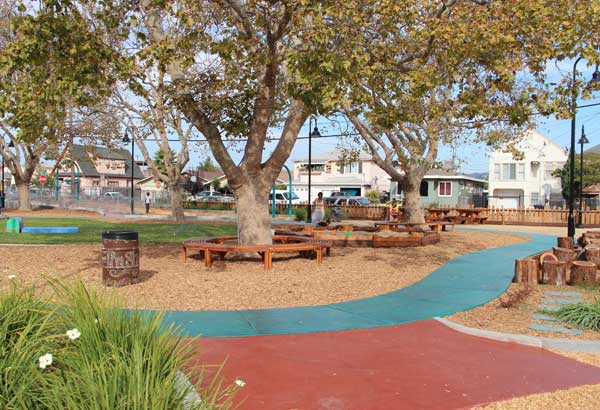 Elm Playlot / KQED, Nancy DeVille
Elm Playlot / KQED, Nancy DeVille
It wasn't just like there was a one-week charrette. We did a five year one! As the great park designer, Susan Goltsman, FASLA, with MIG
in Berkeley, said: "Great playgrounds are in a
constant state of change." They can't just be static. To be alive, parks need to evolve. Pogo Park has been a living charrette.
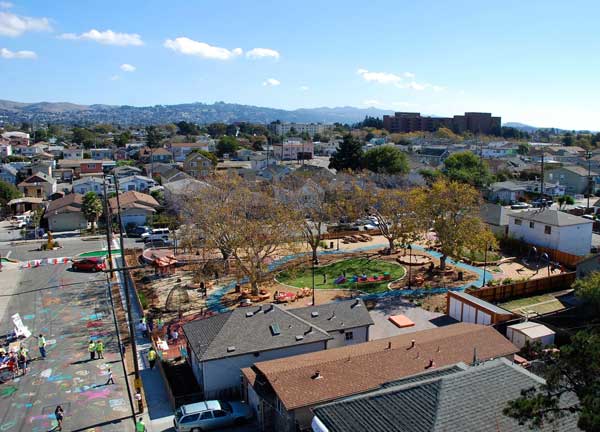 Elm Playlot / Pogo Park
Elm Playlot / Pogo Park
How did the process of 3-D prototyping the park
design work? And why do you think it was better than the typical
approach with charrettes, maps, renderings?
The real language needed to communicate design is the opposite of what you need to understand a landscape architecture plan on paper. With a 3-D model, you get to see what's coming in life size. You're actually experiencing it. If we want to put a tree somewhere, we'll just go out and buy a tree in a five gallon bucket and put it there, so people can actually say, "Oh, a tree's there." They can walk around and see spaces.
I've noticed that when I'm dealing with some landscape architects and designers, they come out with the dimensions of what something should be right away. They'll say, "Oh, well, why don't we put the door at three feet and this at two feet." And they work all by numbers. But our approach is: "Do not impose a number." First of all, mark it, and when it feels right, measure. That is the measurement that goes on the paper. So many times when design is done on paper, it looks good on paper, because it's all math. But when you build it, there's so many little things that were off. The spacing is usually off. The only way you can really get spacing is to do it.
Pogo Park involved the community in the actual construction of the park, paying neighbors of the park to build it. How did the process of co-developing the park with the community work?
We have put over $1 million in wages and contracts into the Iron Triangle.
Everyone expects people who are poor and have no job to come in and volunteer.
Everywhere I went, people said: "Oh, Toody, you and your volunteers."
No. Everyone was paid for their contribution.
We were also blessed to partner with Scientific Art Studio, which happens to have a 2-acre fabrication studio six blocks from our park in the Iron Triangle, to build the park. The guy who runs it -- Ron Holthuysen -- is a world famous designer of children's play spaces. He's the bomb. He just did a $3.5 million new playground for the San Francisco Zoo. His belief is that children must be free to run wild and to explore.
Ron helped us figure out how to work with a playground safety inspector. We were building custom-made, artisanal play elements. Every step of the way we made sure we conformed with the safety regulations. He set up a studio for us in his studio where he acted as our training wheels, empowering local people to do it for themselves.
It was this holy trinity. First, we had community residents. Second, we had the city of Richmond, which is very entrepreneurial and forward thinking. They gave us the green light to do this radical thing: to try and build a park with the community by hand. And, third, we had Ron from Scientific Arts. However, the residents were the most powerful force. All we did was create a system where someone could think up an idea and then just do it. Residents started getting into it, saying things like: "Well, we should put a bench there." So then we would just go to Ron's shop and build a bench and bring it back. Residents started gaining a lot of confidence by thinking, doing.
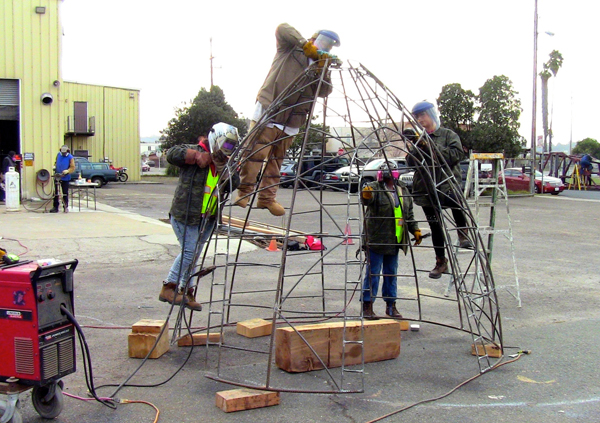 Play element construction / Pogo Park
Play element construction / Pogo Park
The numbers who have been employed with Pogo Park over the past decade
is around 110-120 community residents. We've had probably
another 250 who come and work for two weeks. But we primarily pour our
money into our core staff. We have 10 people on the
community resident team now that work between 15 hours a week and
full-time. And they're paid between $16 and $22 an hour. Those working
full-time have full health, dental, and vision
benefits. All of these people have never had insurance before. Pogo Park
has definitely helped transform the lives of the key folks on our
team. And we now have $1.5 million in contracts to design and build more
parks in Richmond, too.
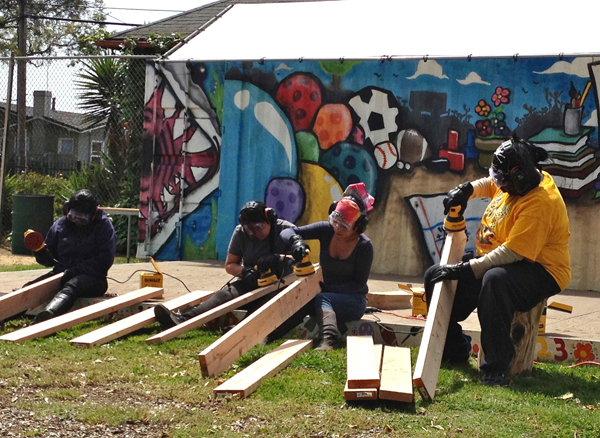 Park construction / Pogo Park
Park construction / Pogo Park
About 25 percent of our team does
cleaning
and maintenance. It's a lot of work, because you're cleaning not
only the park, but also the
streets around the park. When people come into our
block, they can just feel it, because the streets are all clean, and
there's all these trees planted. I mean we clean up. Last year, we had
15,000 kids sign in at our sites. And these kids play hard,
so things get broken. You have to replace the wooden planks and other
things. When things break things, we take them to a work shop where we
have a team. Our maintenance team
can also build things.
About 50 percent are employed in running
the park. We have a park host who comes in somebody who comes into the
office every day. They put out all the
play stuff and open up the bathrooms. They're the ones scheduling
all the programs Monday through Saturday. The other 25 percent does
outreach and design for The Yellow Brick Road, plants trees, plant
trees, and individual and group skills training. They train community
members on how to use email, resolve conflicts, speak in public, etc.
How do you generate deep community buy in and involvement where others have failed?We just show up every day and keep showing up. Most folks come into a community for a year or two and then leave. And then things go back to what they were. So the community doesn't trust new initiatives, because they too will leave. It's taken us nine years of work in this neighborhood, showing up Monday through Friday and not leaving, to gain that trust.
Some 77,500 neighborhood kids use Elm Playlot and Harbor-8 Parks annually. What do these places try to do about works and what doesn't in terms of play? And, specifically, what's needed to create a safe, welcoming playground in a neighborhood that has a lot of crime?
If you go into any of these neighborhoods, the first thing is you have got to staff the park. What makes it safe is there's someone who's there watching out to make sure the park is clean, safe, and welcoming. Second, parks must be "bespoke," custom made for the particular neighborhood, so they can then be woven into the fabric of the neighborhood. The park has got to have soul. Most of these new plastic playgrounds that are plopped in from a catalogue just don't have soul.
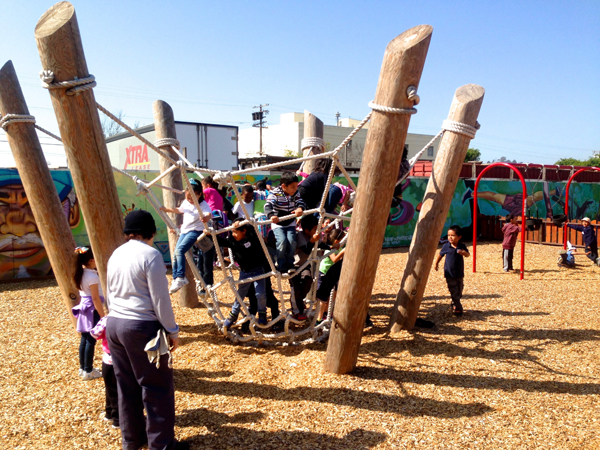 Harbor 8 Park playground / Pogo Park
Harbor 8 Park playground / Pogo Park
The design of the playground has to be generated from the inside out. The community has to be involved and figure out how it's going to weave into the neighborhood. Children's play is very complicated. It's the mother's breast milk of healthy development. Parks departments typically put in static play equipment that's only good for physical play. You go up a ladder and slide down the slide and then go on the swing. But there's all kinds of play: cognitive play, linguistic play, and imaginative, creative play. We have to create playgrounds that meet all the play needs of kids, not just physical needs. That's why we say Pogo Park is an enriched play environment.
How have the new parks helped resolve community conflict and build inter-community trust? And what do you think still needs to happen?
Parks provide a community space for every human being on the planet. We're social beings and gravitate toward public spaces where we can be with other people. Just claiming and holding this space, it becomes a sacred watering hole for the community. That has helped build the trust of the community, because it's a place where people can actually connect in a real way with other residents and families.
You can't just put the bones of the park down. You can't just come into a neighborhood like the Iron Triangle and just plop something down and leave. You have bones but you also have to spirit. The spirit is programming, which makes the park come to life.
Now you're rethinking another form of community space, streets. A project now in the works is the Yellow Brick Road, a "safe, green and clean" route for walking and biking that connects neighborhood schools, parks, transportation, shopping. Pogo Park organized another preview of a full scale 3-D prototype for the community to try out. What is your approach for designing, building, and maintaining this Yellow Brick Road?
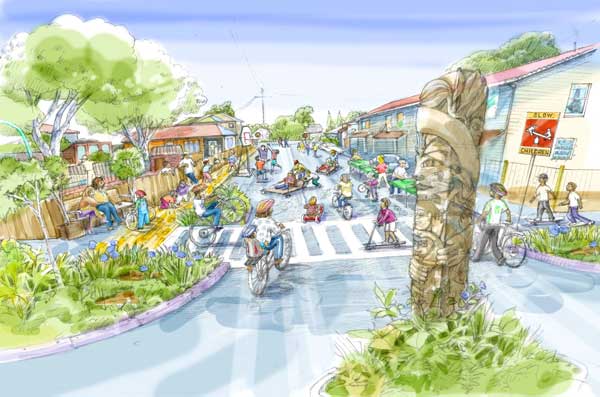 Yellow Brick Road rendering / Pogo Park
Yellow Brick Road rendering / Pogo Park
We used the same 3-D modeling language we used for the parks, but translated it into the streets. We had to slow down traffic on the corners of the park, as we had some 15,000 people sign into the park last year, including thousands of kids. We worked with some of the top transportation engineers to design a new roundabout. We figured out what the dimensions needed to be and then mocked up a 3-D roundabout model. In the middle of the roundabout there is a hand-carved, eight-foot-tall totem pole the Pogo Park community team carved. Over two days, we let the neighborhood, police, and fire fighters actually drive through it.
We've spoken to others who have done 3-D models out of the street, but
they never opened theirs to actual traffic. Neighbors could see what is
going to be built rather than see it on a piece of paper. They could
then add their thoughts right away. The community team, who are people
the neighborhood knows, facilitated. Many neighbors, police, and fire
fighters came up and thanked us so much for this. The 3-D models really
got the community and city involved in a new way. We received a grant from the California department of transportation, and the Yellow Brick Road opened in January.
 Yellow Brick Road demonstration / Richmond Confidential
Yellow Brick Road demonstration / Richmond Confidential
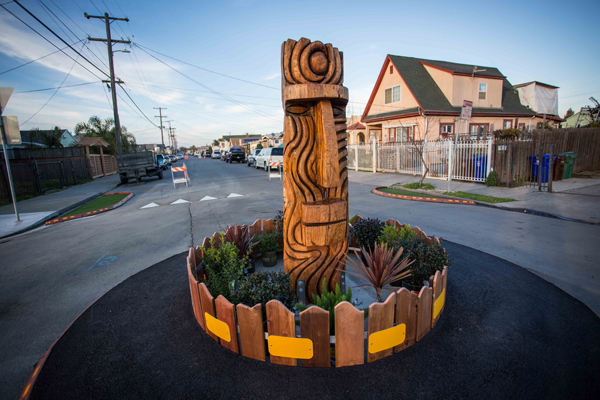 Yellow Brick Road totem pole / Pogo Park
Yellow Brick Road totem pole / Pogo Park
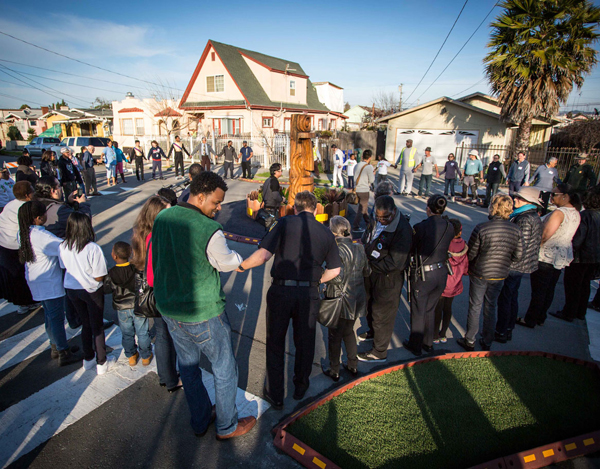 Yellow Brick Road opening, January 2016 / Kaboom.org
Yellow Brick Road opening, January 2016 / Kaboom.org
Toody Maher is the founder and executive director of Pogo Park. She is an artist, inventor, and entrepreneur and lives in the San Francisco Bay Area, California.